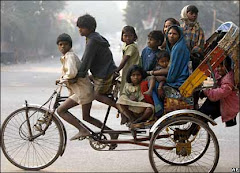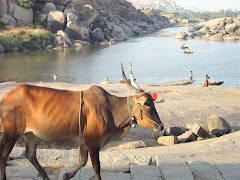
Tiger, Tiger! (by Rudyard Kipling)
What of the hunting, hunter bold?
Brother, the watch was long and cold.
What of the quarry ye went to kill?
Brother, he crops in the jungle still.
Where is the power that made your pride?
Brother, it ebbs from my flank and side.
Where is the haste that ye hurry by?
Brother, I go to my lair to die!
Sadly...Kipling's poem was prophetic.
Growing up with stories of life in India during the time of the British Raj, one of my father's many colourful recollections is of his time at boarding school as a nipper in a hill station deep within India, where an old man was employed to wander back and forth around the deep verandah's of the boarding schools sleeping quarters at night with the sole task of saving the children from becoming tiger tucker. Dad remembers being woken up to reasonably frequent scuffles outside the windows as Tiger Man would bravely fight off the tigers with nothing more than his long stick.
Fast forward 65 odd years, and the plight of the Royal Bengal Tiger is indeed a sorry tale.
Like so many animals on the planet, the Bengal Tiger have been forced into ever decreasing areas as their natural habitat steadily reduces. Between the years 1860 to 1960 a recorded 20,000 tigers were shot as sport. The number of unrecorded tiger deaths from hunting parties (both legal and illegal) and the fur trade during the same period must increase those statistics dramatically. The national tiger census in 1972 recorded a mere 1800 tigers existing in the wilds of India - and after some intervention and the provision of wildlife parks, the number of tigers living in the wild within India grew to around 4000 in 1984. Today the figures are reported to be as low as 1300 or 1400.
It is not uncommon to read stories in the newspapers here of man-eating tigers plucking off the odd villager or two. Of course, and unfortunately, there is only one way to find out if a tiger is a man-eater or not...and lets get real, they are all man-eaters if opportunity and a hungry tiger belly coincide. Villagers in India have lived with the threat of tigers since time immemorial; but with some desperate and hungry tigers out there (and indeed many desperate and hungry villagers with little support) the more common the story of a starving or diseased tiger crossing into human areas to eat some usefully fenced off livestock or village folk - to which the aforementioned desperate and hungry villagers respond to with understandable rage and consequential revenge.
I like to see a wild animal acting like a wild animal - therefore the above video link appeals to me, despite its attack on the boats, which are the only form of transport into the area where this video was shot! The  video above was filmed in the Sundarban National Wildlife Park, which is a most impressive wildlife park within India. The Sundarbans cover 140,000 hectares of pristine forestation in the Ganges Delta. It spans across both India and Bangladesh, with the majority of the area being made up of wetlands and mangrove forest. The largest population of wild Royal Bengal Tiger's are located within this park.
video above was filmed in the Sundarban National Wildlife Park, which is a most impressive wildlife park within India. The Sundarbans cover 140,000 hectares of pristine forestation in the Ganges Delta. It spans across both India and Bangladesh, with the majority of the area being made up of wetlands and mangrove forest. The largest population of wild Royal Bengal Tiger's are located within this park.
The name Sundarbans means 'beautiful jungle' and the area has been under systematic management since the 1860's, with the forest now being a National Park, a Tiger Reserve, an UNESCO World Heritage Site and a Biosphere Reserve.
Management and the footsoldiers on the grounds within the park face an enormous task in protecting the park due to its location falling over two international borders; the location of many villages and tribal people living within the park on both sides of the borders; limited funds; and with constant threat of poachers who can get a small fortune for tiger parts to sell in countries such as China for use in medications, virility potions and whatnot. These various organisations (including government) have a very hard task indeed to maintain the balance for the many endangered species, flora and fauna which still exist in this delicate ecosystem, including the Royal Bengal Tiger.
The tiger has always been greatly respected within India, with it being represented extensively in religious symbolism and government emblems, as well as by the Indian nation at large in many forms. Coming from a country where we have a cute fat beloved flightless brown bird as our national icon, I cannot help being slightly jealous of India having the wonderful regal mysterious, strong and powerful tiger as its symbol!
In India's quest to become a veritable tiger on the world stage, I sincerely hope the powers that be (in conjunction with the international contributors) are able to increase their efforts to save the remaining tigers before it is too late.
The clock ticks loudly for the Royal Bengal Tiger...

 video above was filmed in the Sundarban National Wildlife Park, which is a most impressive wildlife park within India. The Sundarbans cover 140,000 hectares of pristine forestation in the Ganges Delta. It spans across both India and Bangladesh, with the majority of the area being made up of wetlands and mangrove forest. The largest population of wild Royal Bengal Tiger's are located within this park.
video above was filmed in the Sundarban National Wildlife Park, which is a most impressive wildlife park within India. The Sundarbans cover 140,000 hectares of pristine forestation in the Ganges Delta. It spans across both India and Bangladesh, with the majority of the area being made up of wetlands and mangrove forest. The largest population of wild Royal Bengal Tiger's are located within this park.






















No comments:
Post a Comment